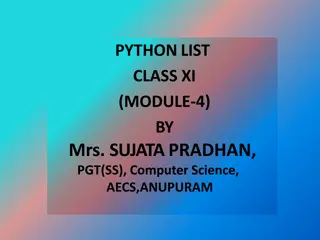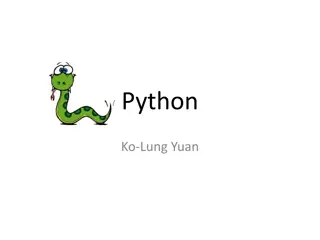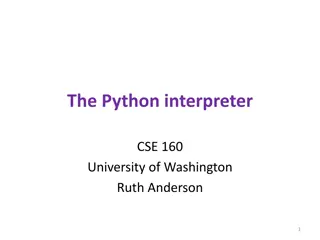Python List Operations and Usage in Programming
Lists in Python are versatile data structures that allow storing an ordered sequence of items. This article covers the basics of lists, key operations such as indexing, slicing, concatenation, repetition, membership checks, and traversing lists using loops. Understanding these fundamental concepts is essential for effective manipulation of lists in Python programming.
Download Presentation

Please find below an Image/Link to download the presentation.
The content on the website is provided AS IS for your information and personal use only. It may not be sold, licensed, or shared on other websites without obtaining consent from the author. Download presentation by click this link. If you encounter any issues during the download, it is possible that the publisher has removed the file from their server.
E N D
Presentation Transcript
PYTHON LIST CLASS XI (MODULE-2) BY Mrs. SUJATA PRADHAN, PGT(SS),Computer Science, AECS,ANUPURAM
Lists & Operations on list: Lists List is an ordered sequence of items. Values in the list are called elements / items.It can be written as a list of comma-separated items (values) between square brackets[ ].Items in the list can be of different data types and List is mutable. Operations on list: Indexing Slicing Concatenation Repetitions Updating Membership Comparison
Indexing Indexing means referring to an element of an iterable by its position in a sequence.
Slicing Slicing means getting a subset of elements from an iterable based on their indices.
Concatenation& Repetition Concatenation is done by + operator. Concatenation is supported by sequence data types(string, list, tuple). Concatenation is done between the same data types only. Concatenating two list objects l1=[1,2] l2=[3,4] print (l1+l2) Output: [1, 2, 3, 4] Repetition :Sequences datatypes support a repetition operator *. The repetition operator * will make multiple copies of that particular object and combines them together. When * is used with an integer it performs multiplication but with list, tuple or strings it performs a repetition. Repetition operator on List l1=[1,2,3] print (l1 * 3) Output: [1, 2, 3, 1, 2, 3, 1, 2, 3] The concatenation and repetition operators are supported only by sequence datatypes . Both concatenation and repetition always result in a new object. Concatenation is done only between the same datatypes .
Membership Operation Membership Operators are the operators, which are used to check whether a value/variable exists in the sequence. This operator returns either True or False, if a value/variable is found in the list, it returns True otherwise it returns False. x = ["apple", "banana"] print("banana" in x) # returns True because a sequence with the value "banana" is in the list x = ["apple", "banana"] print("pineapple" not in x) # returns True because a sequence with the value "pineapple" is not in the list
Traversing a List We can access each element of the list or traverse a list using a for loop or a while loop.
List using While loop The while loop in Python is used to iterate over a block of code as long as the test expression (condition) is Syntax: while (condition): body of while Sum of elements in list a=[1,2,3,4,5] i=0 sum=0 while i<len(a): sum=sum+a[i] i=i+1 print(sum) Output: 15
Basic List Operations The concatenation (+) and repetition (*) operators work in the same way as they were working with the strings. The repetition operator enables the list elements to be repeated multiple times. Concatenation operator concatenates the list mentioned on either side of the operator. Membership operator returns true if a particular item exists in a particular list otherwise returns false. The for loop is used to iterate over the list elements . Python Expression Results Description len([1, 2, 3]) 3 Length [1, 2, 3] + [4, 5, 6] [1, 2, 3, 4, 5, 6] Concatenation ['Hi!'] * 4 ['Hi!', 'Hi!', 'Hi!', 'Hi!'] Repetition 3 in [1, 2, 3] True Membership for x in [1, 2, 3]: print(x) 1 2 3 Iteration
Updating List values The list elements can also be deleted by using the del keyword. Python also provides us the remove() method if we do not know which element is to be deleted from the list. list = [1, 2, 3, 4, 5, 6] print(list) # It will assign value to the value to the second index list[2] = 10 print(list) # Adding multiple-element list[1:3] = [89, 78] print(list) # It will add value at the end of the list list[-1] = 25 print(list) Output: [1, 2, 3, 4, 5, 6] [1, 2, 10, 4, 5, 6] [1, 89, 78, 4, 5, 6] [1, 89, 78, 4, 5, 25]
Deletion of list values L = [1, 2, 3, 4, 5, 6] # Deleting 2nd element del L[1] print(L) OUTPUT: [1, 3, 4, 5, 6] L = [1, 2, 3, 4, 5, 6] # Deleting elements from 3rd to 4th del L[2:4] print(L) OUTPUT: [1, 3, 6] L = [1, 2, 3, 4, 5, 6] # Deleting the whole list del L
SUMMARY Operations on list Concatenation& Repetition Membership Operation List traversal List updation List comparision

























